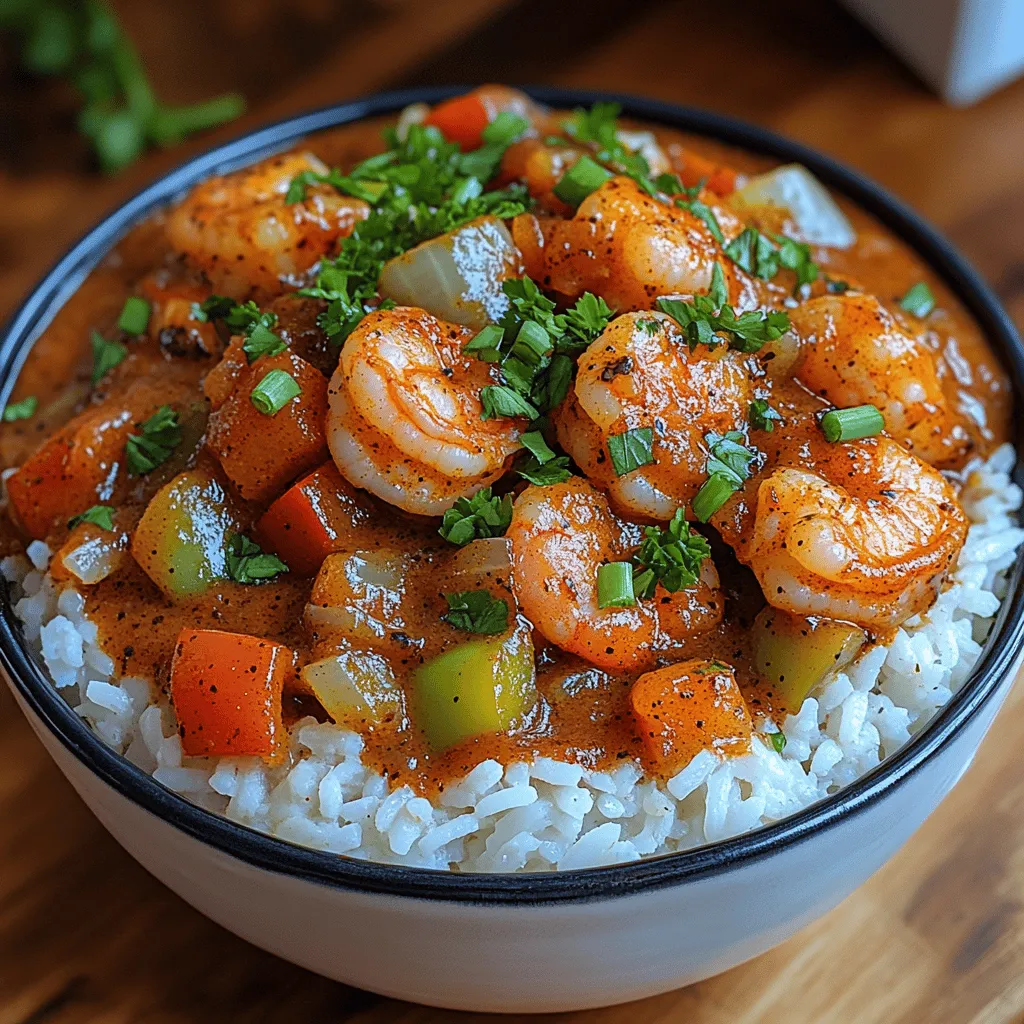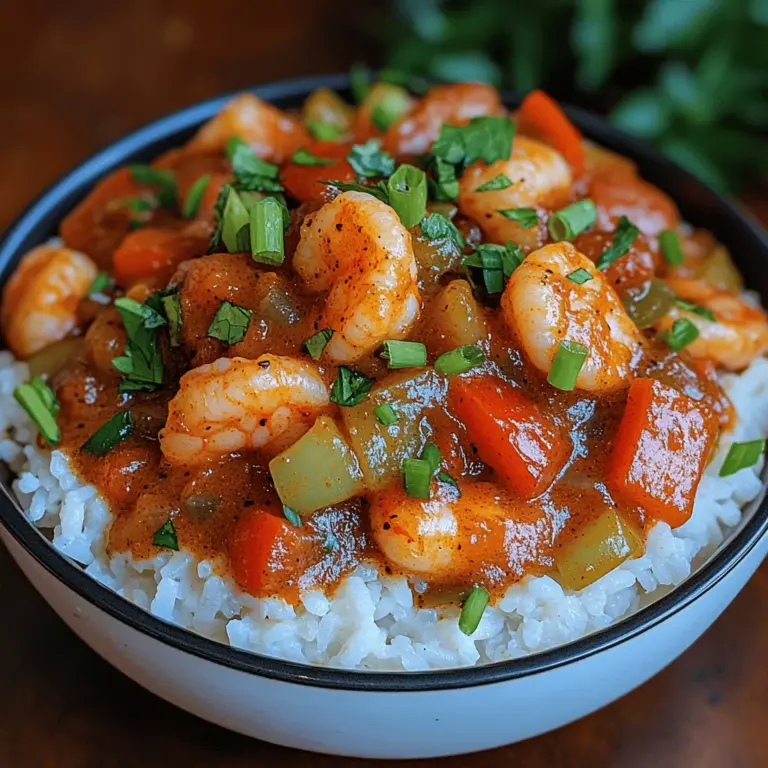Introduction
Cajun cuisine, rich in flavor and history, captures the essence of Louisiana’s vibrant culture. One dish that stands out in this culinary tradition is the Smoky Cajun Shrimp Étouffée. This dish is not only a staple in homes across Louisiana but has also gained popularity among food enthusiasts worldwide for its bold flavors and comforting nature. Étouffée, which translates to “smothered” in French, embodies the spirit of Cajun cooking—simple yet deeply satisfying fare that brings people together around the table.
Growing up in the South, my fondest memories are tied to family gatherings centered around food. One particular evening, as the sun dipped below the horizon, the aroma of sautéed onions, bell peppers, and garlic wafted through the air, signaling that my grandmother was preparing her famous shrimp étouffée. It was a dish that made its way to our table for special occasions, filling our home with warmth and laughter. The smoky heat from the Cajun spices mingled with the sweetness of the shrimp, creating a melody of flavors that lingered long after the last bite. This recipe is not just a meal; it’s a celebration of heritage, love, and culinary artistry.
Cajun cuisine, influenced by French, African, and Native American cultures, is characterized by its use of local ingredients and a blend of spices that create vibrant dishes. The Smoky Cajun Shrimp Étouffée is an exemplary representation of this heritage, showcasing the importance of fresh ingredients, hearty proteins, and the perfect balance of spices. This dish is not only a delight for the palate but also a testament to the rich tapestry of flavors that define Cajun cooking.
In this article, we will delve into the key ingredients that make up this delectable dish, explore the preparation steps, and uncover the cooking techniques that will elevate your culinary skills. Whether you’re a seasoned chef or a novice in the kitchen, this smoky shrimp étouffée recipe is sure to impress your family and friends, bringing a taste of Louisiana into your home.
Understanding the Ingredients
Overview of Key Ingredients
At the heart of any great étouffée lies a carefully curated selection of ingredients. For our Smoky Cajun Shrimp Étouffée, we focus on fresh vegetables, succulent shrimp, and a blend of spices that bring the dish to life. Let’s take a closer look at each component.
Fresh Vegetables
The base of any étouffée is the “holy trinity,” a quintessential combination in Cajun and Creole cooking. This trio consists of onions, bell peppers, and celery. These vegetables not only add flavor but also contribute to the dish’s texture and aroma.
1. Onions: They provide sweetness and depth when sautéed, forming the foundation of the dish.
2. Bell Peppers: Use a mix of colors—green, red, and yellow—to add a pop of color and a slightly sweet, crisp flavor.
3. Celery: Adds a subtle earthiness and crunch, balancing the sweetness of the onions and bell peppers.
Proteins and Their Benefits
The star of our dish is undoubtedly the shrimp. When selecting shrimp for your étouffée, opt for fresh, high-quality shrimp. They should be firm to the touch and have a clean, briny smell. If fresh shrimp is not available, frozen shrimp can be a good alternative, but be sure to thaw them properly before cooking.
Shrimp is a great source of protein, low in calories, and packed with essential nutrients like omega-3 fatty acids and vitamin B12. Their sweet, delicate flavor complements the smoky spices, making them the perfect protein for this dish.
Spices and Seasonings
A hallmark of Cajun cooking is the bold use of spices. For our Smoky Cajun Shrimp Étouffée, the following spices will enhance the flavor profile:
– Cajun Seasoning: A blend of paprika, cayenne pepper, garlic powder, onion powder, and other spices that provide warmth and depth.
– Thyme: Fresh or dried, thyme adds an earthy note that balances the dish.
– Bay Leaves: These impart a subtle herbal flavor and should be removed before serving.
Importance of Quality Ingredients
The success of your Smoky Cajun Shrimp Étouffée hinges on the quality of the ingredients. Fresh, high-quality vegetables and proteins not only enhance the flavor but also ensure a vibrant and visually appealing dish. When shopping for ingredients, consider visiting local farmers’ markets or seafood markets to find the freshest options.
How to Select Fresh Produce
When selecting vegetables, look for bright colors and firm textures. Avoid any produce with blemishes or soft spots, as this may indicate spoilage. For herbs, choose ones that are vibrant in color and fragrant, as this ensures maximum flavor in your dish.
Tips for Choosing the Right Proteins
For shrimp, look for varieties that are wild-caught, as they tend to be more flavorful than farmed options. If possible, ask your fishmonger about the shrimp’s source to ensure you’re getting the best quality. If you’re using frozen shrimp, check for those that are flash-frozen to lock in freshness.
Preparation Steps
Overview of Preparation Techniques
Before diving into cooking, it’s essential to prepare your ingredients properly. This involves chopping and dicing vegetables, marinating proteins, and gathering the necessary kitchen tools.
Chopping and Dicing Vegetables
Start by peeling and dicing the onions, bell peppers, and celery. Aim for uniform pieces to ensure even cooking. A sharp chef’s knife is your best friend in this process. Here’s a quick guide on how to chop each vegetable:
1. Onions: Cut off the top and bottom, peel off the skin, and slice in half. Place the flat side down and slice vertically, then crosswise to create small dice.
2. Bell Peppers: Cut off the top and bottom, remove the seeds and membranes, then slice into strips before dicing.
3. Celery: Cut off the ends, wash thoroughly, and slice into small pieces.
Marinating Proteins
While shrimp are often cooked quickly, marinating them can intensify their flavor. For this recipe, a simple marinade of olive oil, Cajun seasoning, and a splash of lemon juice will enhance the shrimp’s natural sweetness. Allow them to marinate for at least 15-30 minutes before cooking to let the flavors meld.
Essential Kitchen Tools and Equipment
Having the right tools can make the cooking process smoother and more enjoyable. Here are some essential items you’ll need for making Smoky Cajun Shrimp Étouffée:
– Knives: A chef’s knife for chopping vegetables and a paring knife for finer tasks.
– Cutting Boards: Use separate boards for meats and vegetables to prevent cross-contamination.
– Cookware: A heavy-bottomed pot or Dutch oven is ideal for sautéing vegetables and simmering the étouffée.
– Measuring Cups and Spoons: Accurate measurements are crucial for seasoning, so keep these on hand.
Cooking Techniques
Detailed Explanation of Cooking Methods Used in the Recipe
The preparation of Smoky Cajun Shrimp Étouffée involves several cooking techniques that enhance the flavors and textures of the dish. Understanding these methods will help you achieve the best results.
Sautéing vs. Roasting
In this recipe, we will primarily use the sautéing method. Sautéing involves cooking food quickly in a small amount of oil over high heat. This technique is perfect for the “holy trinity” of vegetables, as it allows them to soften while retaining their vibrant colors and flavors.
While roasting is another excellent method for cooking vegetables, it tends to take longer and can result in a different texture. Sautéing the vegetables in this recipe will create a base that’s full of flavor and ready to absorb the spices.
Importance of Temperature Control
Temperature control is crucial when sautéing. Start with medium-high heat to ensure that the oil is hot enough to sear the vegetables quickly. If the heat is too low, the vegetables will steam rather than sauté, resulting in a less flavorful base. Conversely, if the heat is too high, the vegetables can burn, leading to an unpleasant taste.
By maintaining the right temperature, you’ll achieve perfectly sautéed vegetables that serve as the flavorful foundation for your Smoky Cajun Shrimp Étouffée.
As we move forward, we will explore the final steps of this recipe, where the magic happens, and the dish comes together to tantalize your taste buds. Stay tuned for the next segment, where we will dive into the cooking process and bring this rich, smoky étouffée to life.

Step-by-Step Breakdown of the Cooking Process
Creating a delicious Smoky Cajun Shrimp Étouffée is a rewarding culinary endeavor. This dish is a classic example of Southern comfort food, and with the right technique, you can achieve a rich, flavorful result. To ensure the best outcome, follow these step-by-step instructions closely.
1. Prepare the Roux:
– In a heavy-bottomed pot or Dutch oven, heat the vegetable oil over medium heat. Once hot, gradually whisk in the flour. Continue stirring constantly for about 15 to 20 minutes until the roux turns a deep brown color, similar to chocolate. Be patient; this step is crucial for developing the dish’s flavor base.
2. Add Aromatics:
– Once the roux is ready, stir in the chopped onions, bell peppers, and celery (the holy trinity of Cajun cooking). Sauté for about 5 to 7 minutes until the vegetables are tender and fragrant. Add minced garlic and cook for an additional minute, allowing the garlic to soften but not burn.
3. Incorporate the Spices:
– Sprinkle in your Cajun seasoning, smoked paprika, dried thyme, and cayenne pepper. Stir well to combine with the roux and vegetables, cooking for another 2 minutes to allow the spices to bloom.
4. Add the Liquid:
– Gradually pour in the chicken or vegetable broth, stirring continuously to prevent lumps from forming. Bring the mixture to a gentle simmer, then reduce the heat to low and let it cook for about 15 minutes. This allows the flavors to meld beautifully.
5. Cook the Shrimp:
– Stir in the shrimp and diced tomatoes. Cook for an additional 5 to 7 minutes, or until the shrimp turn pink and opaque. Be careful not to overcook the shrimp, as they can become tough.
6. Finish the Étouffée:
– Stir in the chopped green onions and parsley for freshness, and adjust the seasoning with salt and pepper as needed. If the mixture is too thick, you can add a little more broth or water to reach your desired consistency.
7. Serve:
– Once everything is well combined and cooked through, remove from heat. Your Smoky Cajun Shrimp Étouffée is now ready to be plated.
Tips for Achieving the Perfect Texture
– Roux Consistency: Make sure to keep stirring the roux constantly to avoid burning. A well-cooked roux will lend a nutty flavor and rich color to your étouffée.
– Shrimp Quality: Use fresh or frozen shrimp (thawed) that are deveined and peeled. Larger shrimp will give a more satisfying bite.
– Cooking Time: The shrimp should be added toward the end of the cooking process to prevent them from overcooking and becoming rubbery. Keep an eye on them as they cook quickly.
– Thickness Control: If your étouffée is too thick, adding a splash of broth or water will help adjust the texture. It should be saucy, not soupy.
Serving Suggestions
Presentation is key when serving your Smoky Cajun Shrimp Étouffée. Here are some creative ideas to elevate your dish:
1. Plating Techniques:
– Serve the étouffée over a mound of fluffy white rice or quinoa for a beautiful contrast. Use a ring mold to create a neat shape if desired.
– A shallow bowl or plate can showcase the delicious sauce, allowing it to pool around the rice.
2. Garnishing Options:
– Top the dish with freshly chopped green onions and parsley for a burst of color and freshness.
– A sprinkle of Cajun seasoning or a finely chopped jalapeño can add a bit of heat and visual appeal.
3. Pairing Ideas with Side Dishes or Beverages:
– Serve with crusty French bread or cornbread to soak up the rich sauce. A side of coleslaw can provide a crunchy contrast to the creamy étouffée.
– For beverages, consider pairing with a crisp white wine like Sauvignon Blanc or a light beer. Sweet tea is also a classic Southern accompaniment.
4. Complementary Flavors and Textures:
– Consider adding a side of sautéed green beans or a mixed green salad with a tangy dressing to balance the richness of the étouffée.
– A dollop of sour cream or Greek yogurt can provide creaminess that complements the dish beautifully.
Nutritional Information
Understanding the nutritional profile of your Smoky Cajun Shrimp Étouffée can help you enjoy it as part of a balanced diet:
– Calories: A typical serving of shrimp étouffée contains approximately 350-400 calories, depending on the ingredients and portion sizes.
– Macronutrients: Each serving provides a good balance of protein (from the shrimp), carbohydrates (from the rice), and healthy fats (from the oil used in the roux).
– Micronutrients: The dish is rich in vitamins and minerals, including Vitamin C from the bell peppers and tomatoes, and essential antioxidants from the spices.
– Health Benefits of Key Ingredients:
– Shrimp is a lean source of protein, low in calories but high in nutrients like Vitamin B12, iodine, and selenium.
– The vegetables used, especially the holy trinity, provide fiber and various vitamins, contributing to overall health.
– Spices like cayenne and paprika not only enhance flavor but also have antioxidant properties, which can aid in reducing inflammation.
Cultural Significance
Smoky Cajun Shrimp Étouffée is more than just a dish; it represents the rich cultural tapestry of Louisiana cuisine.
– Historical Background: Étouffée, which means “to smother” in French, has its roots in Cajun and Creole cooking. It traditionally features a thick sauce served over rice, showcasing the area’s agricultural bounty and seafood availability.
– Origin and Evolution: The dish likely evolved from French techniques brought to Louisiana, blending with local ingredients and flavors. Over time, variations emerged across the state, with different families adding their own unique twists.
– Variations of the Recipe: Across regions, you might find seafood étouffée made with crawfish, crab, or even chicken. Each version highlights local ingredients and personal preferences.
– Regional Adaptations and Ingredient Swaps: In some areas, you might see the addition of okra for added texture, or a different mix of spices based on local tastes.
Conclusion
The Smoky Cajun Shrimp Étouffée is a celebration of flavor, culture, and culinary tradition. With its rich roux, tender shrimp, and aromatic vegetables, this dish offers a delightful dining experience that embodies the essence of Southern cooking.
Cooking and sharing meals like this étouffée not only satisfy our taste buds but also create lasting memories with family and friends. As you explore this recipe, don’t hesitate to add your personal touch—experiment with different spices, adjust the heat level, or incorporate seasonal vegetables. The joy of cooking comes from creativity and the shared experience of enjoying delicious food together. Embrace the journey, and enjoy every bite of your Smoky Cajun Shrimp Étouffée.


